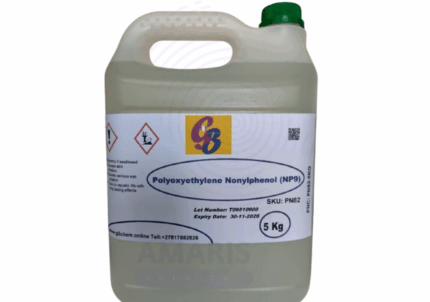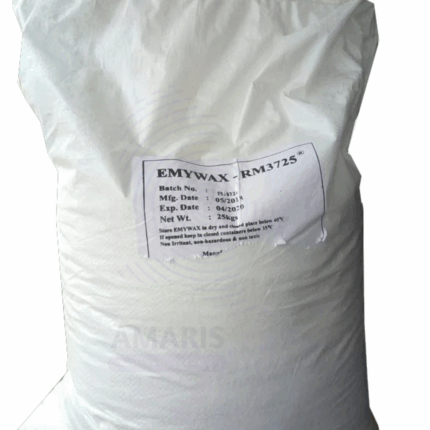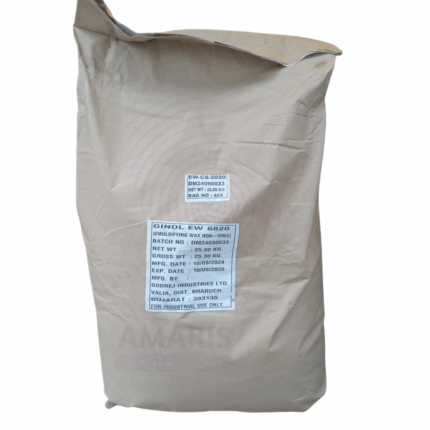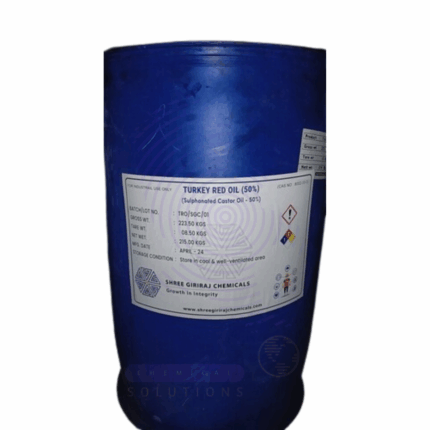Ceteareth 20 Ginonic
Ceteareth 20 Ginonic CSA 20 is a nonionic surfactant and emulsifier derived from the ethoxylation of cetearyl alcohol, incorporating approximately 20 ethylene oxide units per molecule. It appears as a white to off-white waxy solid or viscous liquid, depending on temperature and formulation. This emulsifier is widely used in cosmetic, pharmaceutical, and industrial formulations for its excellent ability to stabilize oil-in-water emulsions, improve texture, and enhance the sensory properties of finished products. Its high hydrophilic-lipophilic balance (HLB) makes it especially effective in forming stable emulsions and solubilizing lipophilic ingredients in aqueous phases. Ceteareth 20 is valued for its mildness, broad compatibility, and multifunctional performance.
Ceteareth 20 Ginonic (CSA 20)
Primary Uses
- Cosmetics & Personal Care
- Emulsifier and solubilizer in creams, lotions, milks, and body butters for stable oil-in-water emulsions.
- Enhances texture, spreadability, and skin feel of moisturizers, sunscreens, cleansers, and makeup products.
- Mild surfactant component in shampoos, conditioners, body washes, and intimate hygiene products.
- Solubilizes essential oils, fragrances, and lipophilic actives in aqueous-based formulations.
- Thickener and stabilizer in personal lubricants and deodorants.
- Pharmaceuticals
- Emulsifying agent in topical creams, ointments, gels, and transdermal delivery systems.
- Improves solubility and bioavailability of poorly water-soluble drugs.
- Enhances formulation stability and consistency in pharmaceutical emulsions.
- Household & Industrial Products
- Nonionic emulsifier in liquid detergents, surface cleaners, and polishes.
- Used in formulations requiring stable emulsions, such as lubricants, metalworking fluids, and coatings.
Secondary Uses
- Food Industry
- Used in non-food-contact applications related to food packaging coatings and food-grade cosmetics.
- Agricultural Chemicals
- Surfactant/emulsifier in pesticide and herbicide formulations to improve dispersion and adhesion of actives.
- Textile & Leather
- Emulsifier in textile softeners, finishing agents, and leather treatment products to improve softness and water resistance.
- Paints & Coatings
- Stabilizer and emulsifier in water-based paints, inks, and coatings for improved product uniformity and shelf life.
- Oil & Gas
- Emulsifier in drilling fluids and enhanced oil recovery formulations to stabilize emulsions and improve performance.
- Personal Hygiene Products
- Component in wet wipes, cleansing cloths, and foaming products for uniform active ingredient distribution and mild cleansing action.
1. Basic Identification Attributes
- Chemical Name (IUPAC): Polyoxyethylene (20) cetyl/stearyl ether
- Common/Trade Name: Ceteareth 20, Ginonic CSA 20
- CAS Number: 68439-49-6
- HS Code: 3402.19.00
- Molecular Formula: Variable polymeric mixture based on C16–C18 fatty alcohol and ~20 ethylene oxide units
- Synonyms:
- PEG-20 Cetearyl Ether
- Ethoxylated cetearyl alcohol
2. Physical & Chemical Properties
- Physical State: Waxy solid or viscous liquid (temperature dependent)
- Color & Odor: White to off-white; mild or neutral odor
- Melting Point: 45–55°C (varies with grade and processing)
- Boiling Point: Decomposes before boiling
- Density: ~0.98–1.02 g/cm³ at 20°C
- Solubility:
- Soluble in water, alcohols, and glycols
- Insoluble in hydrocarbons and some oils
- Hydrophilic-Lipophilic Balance (HLB): Approximately 15.7 (highly hydrophilic)
- Stability: Stable under normal storage; sensitive to strong acids or bases which may hydrolyze the ether linkages
3. Safety & Hazard Attributes
- Hazard Class (GHS): Not classified as hazardous under normal use conditions
- NFPA Ratings:
- Health: 1
- Flammability: 1
- Reactivity: 0
- Exposure Limits: No specific occupational exposure limits; standard PPE recommended
- Toxicity: Low toxicity; generally considered safe in cosmetic and pharmaceutical concentrations
- Irritation Potential: Generally non-irritating; rare cases of mild skin irritation reported with prolonged exposure
4. Storage & Handling Attributes
- Storage Conditions: Store in a cool, dry, well-ventilated area away from direct sunlight and heat sources
- Container Type: Typically supplied in sealed drums, pails, or bulk containers
- Shelf Life: 24–36 months when stored properly
- Special Handling: Avoid dust formation and prolonged skin contact; use PPE when handling large volumes
5. Regulatory & Compliance Attributes
- Cosmetic Regulatory Status: Compliant with regulations globally (EU, FDA, etc.) for use in cosmetics and personal care products
- REACH Status: Registered under REACH for use in the European market
- Transportation: Not regulated as a hazardous material for transport
- Waste Disposal: Dispose of according to local, regional, and national environmental regulations
6. Environmental & Health Impact
- Ecotoxicity: Low environmental impact; biodegradable under aerobic conditions
- Persistence: Moderate environmental persistence; biodegrades in wastewater treatment systems
- Bioaccumulation: Not expected to bioaccumulate in organisms
- Carcinogenicity/Mutagenicity: No known carcinogenic or mutagenic effects
- Biodegradability: Classified as readily biodegradable
Safety Handling Precautions
- Personal Protective Equipment (PPE):
- Protective gloves and safety goggles when handling large quantities
- Protective clothing recommended to avoid prolonged skin exposure
- Handling Measures:
- Avoid inhaling dust or vapors; ensure adequate ventilation
- Avoid contact with strong acids or bases to prevent degradation
- Storage Measures:
- Keep containers tightly closed and protected from moisture
- Use first-in, first-out (FIFO) inventory management
- Hygiene Practices:
- Wash hands thoroughly after handling
- Do not eat, drink, or smoke while handling the product
First Aid Measures
- Inhalation: Move to fresh air if respiratory discomfort occurs; seek medical attention if symptoms persist
- Skin Contact: Wash affected area with soap and water; seek medical advice if irritation or burns develop
- Eye Contact: Flush eyes with plenty of water for at least 15 minutes; consult a physician if irritation persists
- Ingestion: Rinse mouth with water; seek medical attention if large amounts are ingested
Firefighting Measures
- Fire Hazards: Combustible at elevated temperatures
- Extinguishing Media: Use water spray, foam, dry chemical powder, or CO₂ to extinguish fire
- Special Precautions: Firefighters should wear full protective gear and self-contained breathing apparatus
- Decomposition Products: May emit carbon monoxide, carbon dioxide, and other toxic fumes during combustion


 Preservatives(food)
Preservatives(food) Flavor Enhancers
Flavor Enhancers Acidulants
Acidulants Sweeteners
Sweeteners Antioxidants
Antioxidants Colorants(food)
Colorants(food) Nutraceutical Ingredients (food)
Nutraceutical Ingredients (food) Nutrient Supplements
Nutrient Supplements Emulsifiers
Emulsifiers
 Collectors
Collectors Dust Suppressants
Dust Suppressants Explosives and Blasting Agents
Explosives and Blasting Agents Flocculants and Coagulants
Flocculants and Coagulants Frothers
Frothers Leaching Agents
Leaching Agents pH Modifiers
pH Modifiers Precious Metal Extraction Agents
Precious Metal Extraction Agents
 Antioxidants(plastic)
Antioxidants(plastic) Colorants (Pigments, Dyes)
Colorants (Pigments, Dyes) Fillers and Reinforcements
Fillers and Reinforcements Flame Retardants
Flame Retardants Monomers
Monomers Plasticizers
Plasticizers Polymerization Initiators
Polymerization Initiators Stabilizers (UV, Heat)
Stabilizers (UV, Heat)
 Antifoaming Agents
Antifoaming Agents Chelating Agents
Chelating Agents Coagulants and Flocculants
Coagulants and Flocculants Corrosion Inhibitors
Corrosion Inhibitors Disinfectants and Biocides
Disinfectants and Biocides Oxidizing Agents
Oxidizing Agents pH Adjusters
pH Adjusters Scale Inhibitors( water)
Scale Inhibitors( water)
 Antioxidants(cosmetic)
Antioxidants(cosmetic) Emollients
Emollients Fragrances and Essential Oils
Fragrances and Essential Oils Humectants
Humectants Preservatives
Preservatives Surfactants(cosmetic)
Surfactants(cosmetic) Thickeners
Thickeners UV Filters
UV Filters
 Fertilizers
Fertilizers Soil Conditioners
Soil Conditioners Plant Growth Regulators
Plant Growth Regulators Animal Feed Additives
Animal Feed Additives Biostimulants
Biostimulants Pesticides (Herbicides, Insecticides, Fungicides)
Pesticides (Herbicides, Insecticides, Fungicides)
 Active Pharmaceutical Ingredients (APIs)
Active Pharmaceutical Ingredients (APIs) Excipients
Excipients Solvents(pharmaceutical)
Solvents(pharmaceutical) Antibiotics
Antibiotics Antiseptics and Disinfectants
Antiseptics and Disinfectants Vaccine Adjuvants
Vaccine Adjuvants Nutraceutical Ingredients (pharmaceutical)
Nutraceutical Ingredients (pharmaceutical) Analgesics & Antipyretics
Analgesics & Antipyretics
 Analytical Reagents
Analytical Reagents Solvents(lab)
Solvents(lab) Chromatography Chemicals
Chromatography Chemicals Spectroscopy Reagents
Spectroscopy Reagents microbiology-and-cell-culture-reagents
microbiology-and-cell-culture-reagents Molecular Biology Reagents
Molecular Biology Reagents Biochemical Reagents
Biochemical Reagents Inorganic and Organic Standards
Inorganic and Organic Standards Laboratory Safety Chemicals
Laboratory Safety Chemicals Specialty Laboratory Chemicals(Special Laboratory Equipment)
Specialty Laboratory Chemicals(Special Laboratory Equipment)
 Demulsifiers
Demulsifiers Hydraulic Fracturing Fluids
Hydraulic Fracturing Fluids Scale Inhibitors(oil)
Scale Inhibitors(oil) Surfactants(oil)
Surfactants(oil) Drilling Fluids
Drilling Fluids
 Dyes and Pigments
Dyes and Pigments Bleaching Agents
Bleaching Agents Softening Agents
Softening Agents Finishing Agents
Finishing Agents Antistatic Agents
Antistatic Agents
 Admixtures
Admixtures Waterproofing Agents
Waterproofing Agents Sealants and Adhesives
Sealants and Adhesives Curing Compounds
Curing Compounds Concrete Repair Chemicals
Concrete Repair Chemicals Anti-Corrosion Coatings
Anti-Corrosion Coatings
 Surfactants(cleaning)
Surfactants(cleaning) Builders
Builders Enzymes
Enzymes Solvents (Cleaning)
Solvents (Cleaning) Fragrances
Fragrances
 Electronic Chemicals
Electronic Chemicals Catalysts
Catalysts Lubricants
Lubricants Photographic Chemicals
Photographic Chemicals Refrigerants
Refrigerants Automotive chemicals
Automotive chemicals Pyrotechnic Chemicals
Pyrotechnic Chemicals
 Biodegradable Surfactants
Biodegradable Surfactants Bio-based Solvents
Bio-based Solvents Renewable Polymers
Renewable Polymers Carbon Capture Chemicals
Carbon Capture Chemicals Wastewater Treatment Chemicals
Wastewater Treatment Chemicals
 Pigments
Pigments Solvents(paint)
Solvents(paint) Specialty Coatings
Specialty Coatings Binders/Resins
Binders/Resins Additives
Additives Driers
Driers Anti-Corrosion Agents
Anti-Corrosion Agents Functional Coatings
Functional Coatings Application-Specific Coatings
Application-Specific Coatings
 Fresh Herbs
Fresh Herbs Ground Spices
Ground Spices Whole Spices
Whole Spices Spice Blends
Spice Blends Dried Herbs
Dried Herbs
 Leavening Agents
Leavening Agents Dough Conditioners
Dough Conditioners Flour Treatments
Flour Treatments Fat Replacers
Fat Replacers Decoratives
Decoratives Preservatives(baking)
Preservatives(baking)
 Plasticizers & Softeners
Plasticizers & Softeners Reinforcing Agents
Reinforcing Agents Adhesion Promoters
Adhesion Promoters Vulcanizing Agents
Vulcanizing Agents Antidegradants
Antidegradants Blowing Agents
Blowing Agents Fillers & Extenders
Fillers & Extenders Accelerators & Retarders
Accelerators & Retarders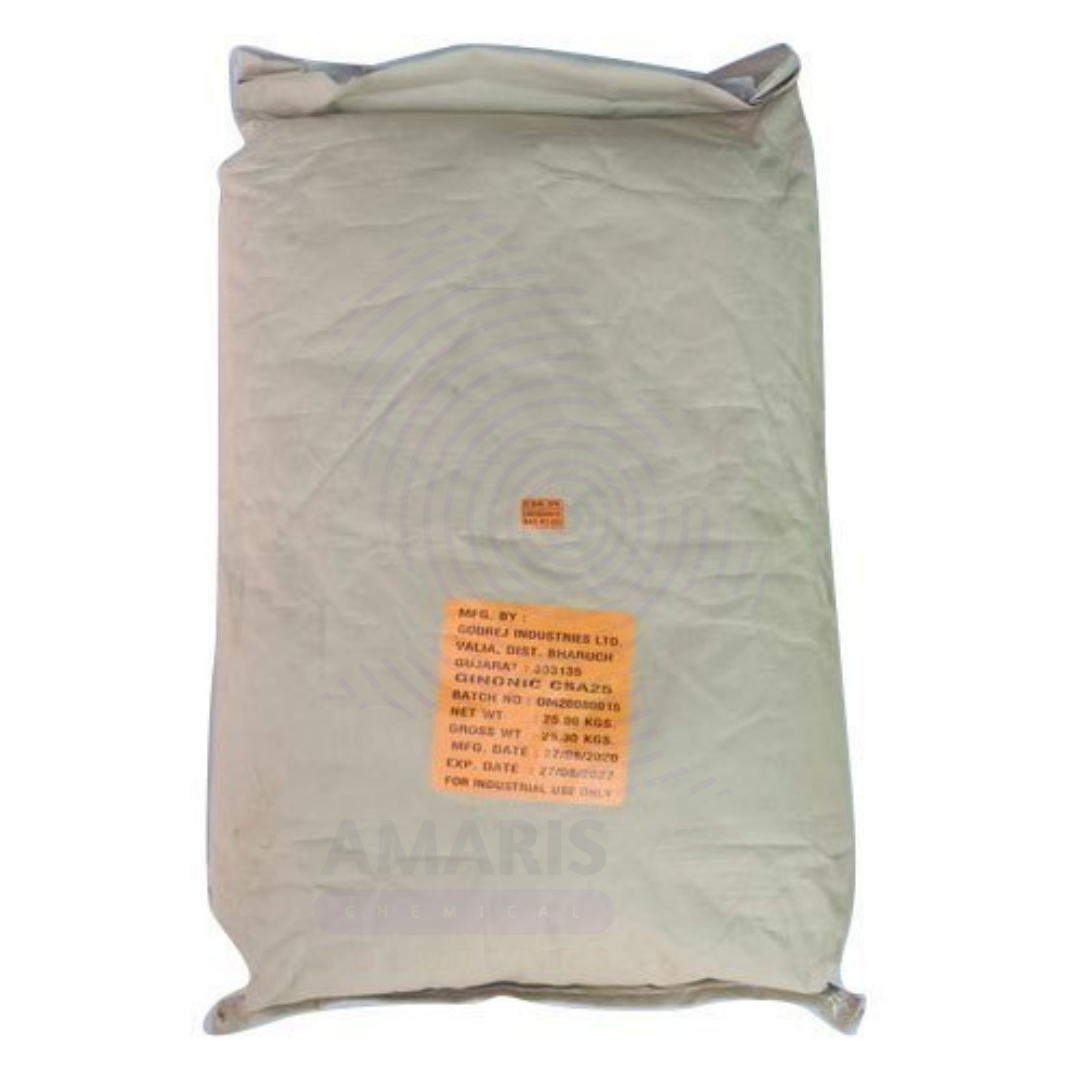

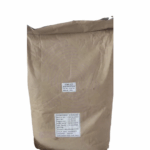


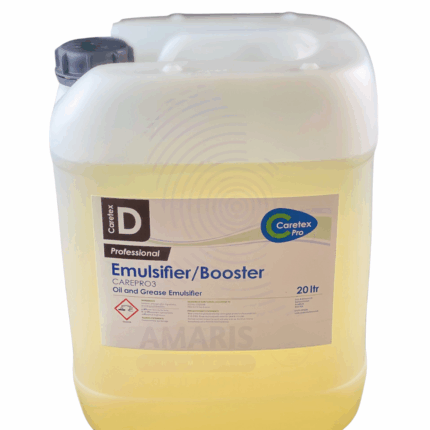
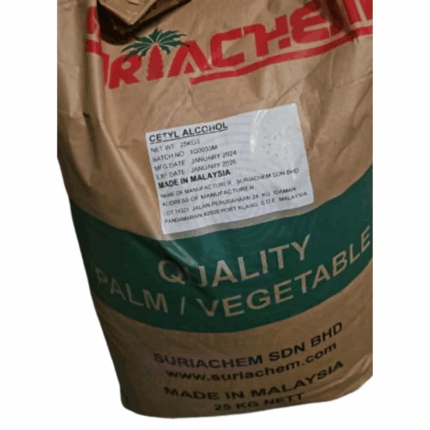
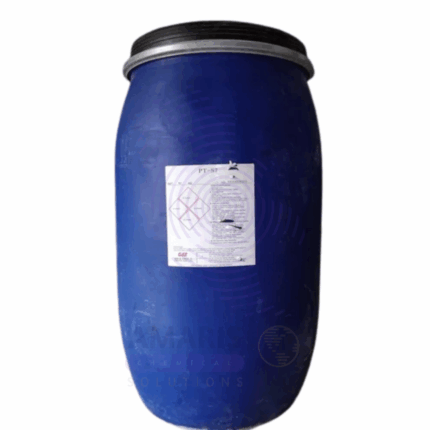
![Diethanolamine [C4H11NO2 or (CH2CH2OH)2NH] Amaris Chemicals](https://amarischemicalsolutions.com/wp-content/uploads/2025/07/Diethanolamine-C4H11NO2-or-CH2CH2OH2NH-Amaris-Chemicals-430x430.png)
